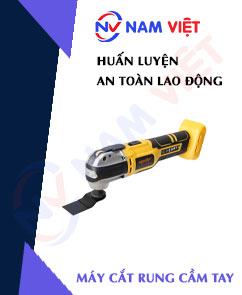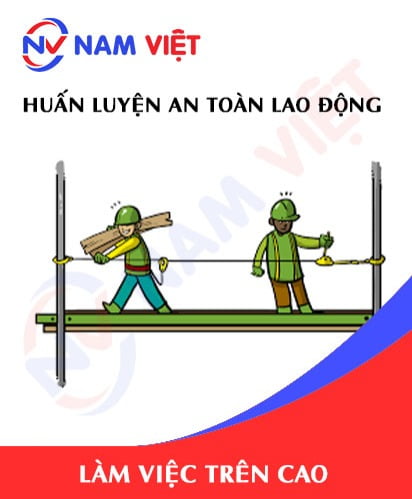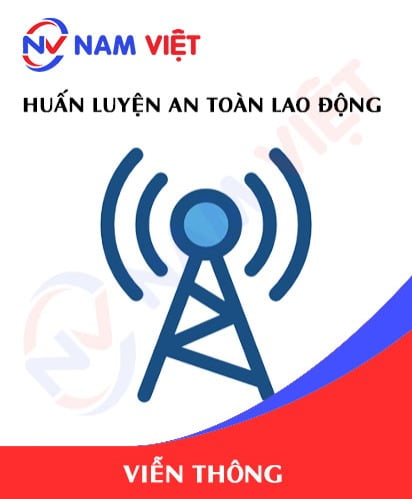Occupational Safety Training for Operating Handheld Vibrating Cutters
99,000 ₫
Note: The price above is calculated per person and may fluctuate depending on the number of participants in the course and market conditions. For more accurate pricing support, please refer to the price list or contact our consulting staff directly.
Occupational safety is an important issue when operating a handheld oscillating cutter and must be addressed promptly to ensure the health and safety of workers and enhance the reputation of businesses here. The Occupational Safety Training course is one of the effective solutions to raise awareness of how to prevent workplace accidents for workers operating a handheld oscillating cutter.
Table of Contents
Toggle1. Overview of Handheld Oscillating Cutters
a. What is a Handheld Oscillating Cutter?
A Handheld Oscillating Cutter (Handheld Speed Oscillating Cutter) is a type of power tool designed for cutting, chiseling, and processing various materials. It is also known as a multifunctional handheld cutter or oscillating blade cutter. The tool works by using a blade that oscillates rapidly in an up-and-down motion. This allows it to perform a variety of tasks, including cutting wood, metal, plastic, fiberglass, and many other materials.
Handheld oscillating cutters are commonly used in the construction industry, interior and exterior decoration, mechanical work, and even in creative crafts. With the ability to switch between different blades and accessories, users can perform tasks such as cutting, chiseling, sanding, scraping, and more using just one device.
The handheld oscillating cutter is easy to control and suitable for multiple applications. The oscillating blade technology reduces noise and vibration compared to many traditional tools, making it an attractive choice for tasks requiring precision and control.

b. How a Handheld Oscillating Cutter Works
The operation principle of a handheld oscillating cutter is based on the oscillating blade mechanism to perform cutting, chiseling, and other processing tasks. Here’s how it works:
- Motor: The handheld oscillating cutter uses an electric motor to generate the mechanical force needed to move the blade or tool head in an oscillating motion.
- Oscillating blade: The tool head or blade is attached using an oscillating mechanism. The motor produces rapid rotational motion, which is converted by the oscillating mechanism into up-and-down or side-to-side motion along a fixed path. This creates high-intensity oscillation at the tool head.
- Cutting and processing: When the blade oscillates rapidly, it can cut or chisel into the target material. The oscillating blade can efficiently cut through wood, metal, plastic, and many other materials, producing clean and fast cuts without requiring much user pressure.
- Control: Handheld oscillating cutters often have options to adjust the oscillation speed and motion type to tailor the cutting and processing according to specific tasks. Users can customize these parameters to suit the job requirements.

c. Industries Using Handheld Oscillating Cutters
Handheld oscillating cutters are used across various manufacturing and production industries. Key industries include:
- Construction: Used for cutting and processing construction materials such as wood, bricks, concrete, and metal, providing clean and precise edges and surfaces.
- Woodworking: In furniture, window, and wood product manufacturing, the tool is essential for cutting and chiseling wood.
- Automotive manufacturing: Used to cut metal, plastic, and other materials during vehicle production and maintenance.
- Handicraft production: In metalwork or wax crafting, the tool can produce customized and precise designs.
- Electronics manufacturing: Used for processing electronic components such as circuit boards and enclosures.
- Art and jewelry production: Artists and jewelers use the cutter to cut and chisel materials like precious metals, gemstones, and wood for creating jewelry and artwork.
2. Overview of Occupational Safety Training for Operating Handheld Oscillating Cutters
a. What is Occupational Safety Training?
- Occupational safety training for operating handheld oscillating cutters consists of lessons that raise awareness on preventing workplace accidents. Workers who operate the cutter directly belong to Group 3.
- The training helps workers identify hazards and prevent accidents, reducing the risks of occupational injuries during work.
REGISTER FOR OCCUPATIONAL SAFETY TRAINING
b. Training Duration
Initial safety training duration:
- Total training time is at least 24 hours, including exams.
- 8 hours of theory on safety policies, laws, and labor hygiene
- 8 hours of theory on basic occupational safety and hygiene knowledge
- 4 hours of theory on specialized training content
- 2 hours of practical exercises on specialized training content
- 2 hours of final theoretical examination
The safety training center arranges sessions according to worker availability, typically in 6 sessions over 3 days if continuous training is possible.
Periodic safety training:
- Before the occupational safety card expires, workers must complete periodic occupational safety training, with the periodic training time being at least 50% of the initial training duration.
Explanation: The total periodic training time is at least 12 hours, including exams. After completing the periodic training and passing the test, workers are reissued and renewed their occupational safety card.
c. Training Content
| No. | TRAINING CONTENT | TRAINING TIME (HOURS) | |||
| Total | Including | ||||
| Theory | Practical | Exam | |||
| I | Policies and laws on occupational safety and hygiene | 8 | 8 | 0 | 0 |
| 1 | Overview of regulations and legal documents on occupational safety and hygiene. | 6 | 6 | ||
| 2 | Standards and technical regulations on occupational safety and hygiene. | 1 | 1 | ||
| 3 | Specific regulations by state authorities on safety and hygiene for constructing, expanding, or renovating facilities; managing, using, storing, and inspecting machines, equipment, materials, and substances with strict safety requirements. | 1 | 1 | ||
| II | Basic occupational safety and hygiene knowledge | 8 | 8 | 0 | 0 |
| 1 | Basic knowledge of hazards and harmful factors in the workplace. | 4 | 4 | ||
| 2 | Methods to improve working conditions. | 1 | 1 | ||
| 3 | Safety culture in production and business. | 1 | 1 | ||
| 4 | Rights and responsibilities of employers and employees; safety policies and procedures; roles of safety officers and networks. | 1 | 1 | ||
| 5 | Safety rules, signs, and instructions; use of safety equipment and personal protective equipment; accident first aid and occupational disease prevention skills. | 1 | 1 | ||
| III | Specialized training content | 6 | 4 | 2 | 0 |
| Comprehensive knowledge of machines, equipment, and hazardous substances; risk analysis and management; safe working procedures with machines, equipment, and substances with strict safety requirements. | 6 | 4 | 2 | ||
| IV | Final safety training examination | 2 | 2 | 0 | 0 |
| Total | 24 | 22 | 2 | ||
See more training content of 6 groups
d. Occupational Safety Card
After completing the safety training and passing the exam, workers are issued an Occupational Safety Card (commonly called Group 3 Safety Certificate).
The Group 3 safety card includes information such as full name, date of birth, specific job, and work environment, as well as training duration, official stamp, and signature confirming course completion.
According to Clause 2 of Article 24 of Decree 44/2016/ND-CP, there are two cases:
- If the employer and employee have a labor contract, the employer must sign, stamp, and validate the safety card after the employee completes training and passes the exam.
- If the worker is freelance or seasonal without a labor contract, the training organization must sign, stamp, and validate the safety card after completing training and passing the exam.

3. Hazards When Operating a Handheld Vibrating Cutter
Operating a handheld vibrating cutter can pose several hazards if safety rules are not followed. Below are some of the main hazards when using a handheld vibrating cutter:
- Injuries from blades and tools: Handheld vibrating cutters use rapidly oscillating blades or tools. If used improperly or without following safety rules, serious injuries can occur if the blade comes into contact with the user or nearby persons.
- Vibration syndrome: Users may be affected by prolonged vibrations, leading to “vibration syndrome” or vibration-related injuries. This can cause health problems such as numbness, joint inflammation, and back pain.
- Mis-cut accidents: During operation, mis-cut accidents can occur if safety rules and personal protective equipment, such as safety glasses and gloves, are not used.
- Electric shock risk: As the handheld cutter is electrically powered, there is a risk of electric shock or electrocution if the machine is damaged or used improperly.
- Overloading: Overusing the handheld cutter can cause machine damage or create dangerous situations for the user.
- Work environment: Handheld cutters often generate noise and dust, and the work environment may be unsafe for health if not properly managed.

4. Measures to Prevent Accidents When Operating a Handheld Vibrating Cutter
To prevent accidents while operating a handheld vibrating cutter, the following safety measures and procedures should be implemented:
- Training and guidance: Ensure all users have been trained on how to safely operate the equipment and understand potential hazards. Users should know how to operate the cutter correctly, perform maintenance, and respond in emergency situations.
- Use personal protective equipment: Ensure all users wear safety glasses, gloves, dust masks (if necessary), and any other PPE recommended by the manufacturer.
- Machine inspection: Conduct regular inspections and maintenance according to the manufacturer’s instructions. Ensure the handheld cutter operates properly and is free of damage.
- Follow operating instructions: Operate the cutter according to the manufacturer’s guidelines and avoid exceeding its capacity. Do not attempt to cut or process materials the machine is not designed for.
- Monitor the work environment: Ensure a safe work environment by controlling noise, dust, and other hazards.
- Manage work zones: Identify and mark work zones, and ensure no one is nearby when the cutter is operating.
- Check for electrical hazards: Ensure the cutter is used in a safe environment with no risk of electric shock.
- Follow safety regulations: Users must adhere to all safety rules and regulations set by the manufacturer, industry standards, and authorities. If a safety issue arises, stop work immediately and disconnect the machine until the problem is resolved.
- Periodic inspection of handheld cutters should be conducted to detect safety issues such as wear or mechanical failures, reducing the risk of workplace accidents.
5. Benefits of Occupational Safety Training
An Toàn Nam Việt provides enterprises with significant benefits upon completing occupational safety training in accordance with Decree 44/2016/ND-CP on occupational safety and hygiene for companies, factories, and businesses.
- Workers can recognize potential hazards and take preventive measures to avoid workplace accidents.
- Enterprises can establish risk prevention measures within production, operation, and maintenance processes.
- Reduce costs associated with workplace safety incidents.
- Uninterrupted production increases labor productivity and product quality.
- Compliance with labor safety laws and regulations, reducing legal risks.
- Enhance credibility and professionalism, boosting the company’s brand reputation.
Nam Việt’s training courses help individuals prevent external hazards, avoiding injuries or even fatalities.
REGISTER FOR OCCUPATIONAL SAFETY TRAINING SERVICE
6. Customer Feedback After Completing Training
An Toàn Nam Việt has years of experience supporting businesses across Vietnam, particularly in the southern provinces. Our commitment is highly valued, which is why our Occupational Safety Training is increasingly professional. The growth of An Toàn Nam Việt is driven by positive feedback and suggestions from our business partners. Below are some testimonials from clients we have served.
See more customer interviews after using our services at An Toàn Nam Việt
7. Occupational Safety Training Capability of An Toàn Nam Việt
An Toàn Nam Việt is a reputable occupational safety training center in Vietnam, conducting training continuously at factories, production workshops, or construction sites across all 63 provinces.
REGISTER FOR OCCUPATIONAL SAFETY TRAINING SERVICE
Occupational Safety Training License
- An Toàn Nam Việt has been inspected and certified by the Safety Department of the Ministry of Labor, Invalids, and Social Affairs for compliance to conduct occupational safety training. This strengthens our training capacity.

Materials and Lectures
- Before being used in training courses, all materials are reviewed to ensure accurate content and effective application.
- Teaching methods are standardized by An Toàn Nam Việt, developed by experts in occupational safety training for maximum learning efficiency.
Facilities
- Controlling classroom conditions improves teaching efficiency and knowledge absorption.
- Training facilities are spacious and meet standards for area, lighting, and equipment.
8. National Reputable and Quality Safety Training Center
At An Toàn Nam Việt, we prioritize occupational safety training. Our goal is to equip workers with knowledge to protect themselves while contributing to national development. We prepare carefully—from tools and teaching equipment to curricula, documents, audio, and lighting.
Our instructors are experienced specialists who have researched hazard identification in all industries. Lectures are practical, engaging, and aligned with Decree 44/2016/ND-CP, helping workers apply safety measures effectively.
Our training center prides itself on professionalism with the following advantages:
- Competitive training costs while maintaining quality.
- Flexible schedules suitable for business production needs.
- Fast, legally compliant certificate issuance.
- Experienced instructors.
- Classrooms optimized for learning efficiency.
- Lectures tailored to workplace safety for businesses.
- Dedicated, professional support for clients.

9. Additional Occupational Safety Training Resources
- Occupational Safety Training Materials
- Safety materials for operating a vibrating cutter
- Occupational Safety Training Test Materials
- Occupational Safety Quiz for Operating a Vibrating Cutter
- Safety Training Slides for Operating a Vibrating Cutter
1 review for Occupational Safety Training for Operating Handheld Vibrating Cutters
No comments yet















phanminhhang341
Giảng viên dạy rất sinh động dễ hiểu!